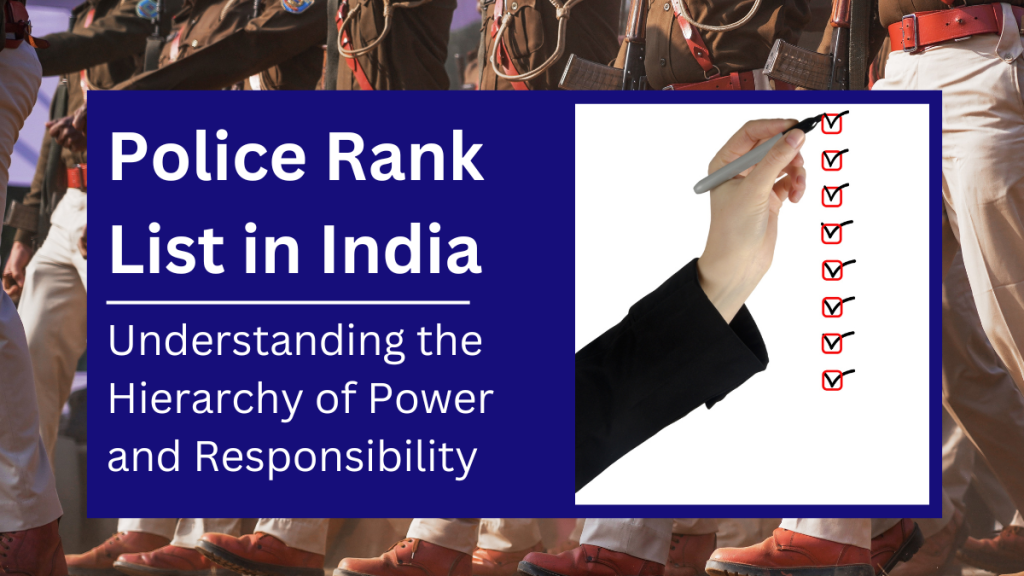The police force is like the strong spine of law enforcement in India. It plays a huge role in keeping peace, making sure laws are followed, and protecting people. If you’re thinking about joining the police, it’s super important to know how the ranks work. This blog will break down the detailed hierarchy of the Indian police, explaining the different ranks, what they do, and why each position matters. Whether you are a student aspiring to don the uniform or simply someone who is curious, this guide will provide you with a good idea of the esteemed ranks that constitute the Indian police force.
The Indian police rank system has at its heart a well-defined, structured system. This helps ensure effective command and control, and it also illustrates how responsibility and authority increase as you progress through the ranks. From the humblest entry-level Constable, with whom people interact for the first time as part of their exposure to law and order forces, to the seniormost Director General of Police (DGP), in charge of an entire state, each rank is distinguished by duties, challenges, and opportunities to deliver a difference in society. To understand this pecking order is vital for anyone embarking on a law enforcement career. It illustrates the career advancement, leadership positions, and authority to decide that accompany every promotion. From Sub-Inspectors conducting investigations to Superintendents administering districts, every grade is an advancement towards greater responsibility and service to the nation.

Understanding the Indian Police Force
India’s police force is a highly organized structure, designed to ensure law and order across the vast and diverse nation. The force operates under a hierarchical system where each rank carries specific responsibilities and authority. The hierarchy is divided into two broad categories: the Gazetted Officers and the Non-Gazetted Officers. The former includes officers from the rank of Assistant Superintendent of Police (ASP) and above, while the latter encompasses the ranks from Constable to Inspector.
Gazetted Officers
Gazetted officers in India are individuals whose names are listed in the official government publication, the Indian Gazette. These officers hold substantial authority and are entrusted with important decision-making and policy implementation responsibilities. Their role is vital in various administrative and governmental functions, and their signature or seal is often required for certifying documents and verifying the authenticity of official papers.
Non-Gazetted Officers
Non-Gazetted officers, though not listed in the Gazette, form the operational backbone of the police force. They are primarily responsible for ground-level law enforcement, conducting investigations, and engaging directly with the public. These officers play a important role in maintaining day-to-day order and implementing the directives of higher-ranking officials, ensuring that the force functions effectively at the grassroots level.
Detailed Overview of Police Ranks in India
The police rank structure in India is carefully organized, with each rank important for maintaining law and order. Below is a detailed overview of the ranks, starting from the highest positions down to the entry-level roles, highlighting their significance in the effective functioning of the police force:
Director General of Police (DGP)
- Role and Responsibility: The DGP is the highest-ranking police officer in a state or Union Territory. They are responsible for overseeing the entire police force, setting policies, and ensuring that law enforcement is carried out effectively.
- Insignia: Crossed sword and baton with a national emblem above them.
- Appointment: Appointed by the state government.
Additional Director General of Police (ADGP)
- Role and Responsibility: The Additional Director General of Police (ADGP) supports the Director General of Police (DGP) in overseeing the police force. They often lead specific departments like law and order, crime, or intelligence, ensuring that these areas operate efficiently and effectively under the broader strategic directives of the police leadership.
- Insignia: Three stars above a crossed sword and baton with a national emblem.
- Appointment: Appointed by the state government.
Inspector General of Police (IGP)
- Role and Responsibility: The Inspector General of Police (IGP) oversees a zone comprising multiple districts. They ensure the effective implementation of policies and directives set by the Director General of Police (DGP) within their jurisdiction, coordinating law enforcement efforts and managing resources across the zone to maintain public order.
- Insignia: One star above a crossed sword and baton with a national emblem.
- Appointment: Appointed by the state government.
Deputy Inspector General of Police (DIG)
- Role and Responsibility: The Deputy Inspector General of Police (DIG) manages several districts within a zone and reports directly to the Inspector General of Police (IGP). They are responsible for overseeing law enforcement and administrative functions within their jurisdiction, ensuring effective implementation of policies and coordination across the districts.
- Insignia: Three stars in a triangular formation above a crossed sword and baton.
- Appointment: Appointed by the state government.
Superintendent of Police (SP)
- Role and Responsibility: The SP is the head of the police force in a district. They manage all the police stations within their district and are responsible for maintaining law and order, preventing and investigating crimes, and ensuring the effective functioning of the police force.
- Insignia: One star above a crossed sword and baton.
- Appointment: Appointed by the state government.
Additional Superintendent of Police (ASP)
- Role and Responsibility: The Assistant Superintendent of Police (ASP) supports the Superintendent of Police (SP) in managing the district police force. They may oversee specific areas or functions, such as rural policing, traffic management, or specialized units, ensuring effective law enforcement and administrative operations within their designated responsibilities.
- Insignia: Three stars.
- Appointment: Appointed by the state government.
Deputy Superintendent of Police (DSP)
- Role and Responsibility: The Deputy Superintendent of Police (DSP) manages a sub-division within a district. They oversee the functioning of police stations in their area, ensure the maintenance of law and order, and handle investigations into major crimes, ensuring effective policing and prompt resolution of significant cases.
- Insignia: Three stars.
- Appointment: Appointed through the state public service commission.
Inspector of Police
- Role and Responsibility: The Inspector heads a police station, overseeing all activities within the station. Their responsibilities include crime prevention, conducting investigations, and maintaining public order, ensuring that the station operates efficiently and effectively in addressing and resolving local law enforcement issues.
- Insignia: Two stars.
- Appointment: Promoted to Sub-Inspector.
Sub-Inspector of Police (SI)
- Role and Responsibility: The Sub-Inspector (SI) serves as the first investigating officer in the hierarchy. They manage the day-to-day activities of a police station, including initial investigations and administrative tasks, under the guidance and supervision of the Inspector, ensuring effective law enforcement and resolution of cases.
- Insignia: Two stars.
- Appointment: Appointed through the state public service commission.
Assistant Sub-Inspector of Police (ASI)
- Role and Responsibility: The Assistant Sub-Inspector (ASI) supports the Sub-Inspector (SI) in investigations and handles specific duties such as maintaining records, supervising constables, and managing arms and ammunition. Their role is important in ensuring smooth operations and effective law enforcement within the police station.
- Insignia: One star.
- Appointment: Promoted from Head Constable.
Head Constable
- Role and Responsibility: The Head Constable oversees the constables and acts as a liaison between the officers and constables. They handle administrative duties, supervise daily tasks, and assist in investigations, ensuring effective communication and coordination within the police station for efficient law enforcement operations.
- Insignia: Three chevrons.
- Appointment: Promoted from Constable.
Constable
- Role and Responsibility: Constables form the base of the police hierarchy. They maintain law and order, patrol areas, assist in investigations, and enforce laws at the grassroots level, playing an important role in the day-to-day operations of law enforcement and community safety.
- Insignia: No insignia.
- Appointment: Entry-level position, recruited through state-level examinations.
Table: Police Rank Insignia and Appointment
| Rank | Insignia | Appointment |
| Director General of Police (DGP) | Crossed sword and baton with national emblem above | Appointed by the state government |
| Additional DGP (ADGP) | Three stars above crossed sword and baton | Appointed by the state government |
| Inspector General of Police (IGP) | One star above crossed sword and baton | Appointed by the state government |
| Deputy IG of Police (DIG) | Three stars in a triangular formation | Appointed by the state government |
| Superintendent of Police (SP) | One star above crossed sword and baton | Appointed by the state government |
| Additional SP (ASP) | Three stars | Appointed by the state government |
| Deputy SP (DSP) | Three stars | Appointed through the state public service commission |
| Inspector of Police | Two stars | Promoted from Sub-Inspector |
| Sub-Inspector (SI) | Two stars | Appointed through the state public service commission |
| Assistant Sub-Inspector (ASI) | One star | Promoted from Head Constable |
| Head Constable | Three chevrons | Promoted from Constable |
| Constable | No insignia | Entry-level position, recruited through state-level examinations |
The Journey of an Aspiring Police Officer: From Recruitment to Rank
Aspiring to join the police force in India is a noble ambition that requires dedication, hard work, and an understanding of the recruitment process. Whether you aim to start as a Constable or an officer at a higher rank, the journey is marked by rigorous training, examinations, and a deep commitment to upholding the law.
Recruitment Process: Entry Points into the Indian Police
The recruitment process for different ranks in the Indian police force varies based on the position. Entry-level roles like Constables require a basic educational qualification and physical tests, while Sub-Inspectors need a graduate degree and pass state-level exams. For higher ranks such as Deputy Superintendent of Police (DSP) and Indian Police Service (IPS) officers, candidates must clear rigorous exams and interviews. Each level has its own set of qualifications and selection criteria:
- Constable Recruitment:
- Eligibility: Candidates typically need to have completed their 10th or 12th standard education. The age limit usually ranges from 18 to 25 years.
- Selection Process: The selection process includes a written examination, physical efficiency test, and an interview. Successful candidates undergo basic police training at a police academy.
- Training: The training for constables focuses on physical fitness, basic law enforcement skills, and community policing.
- Sub-Inspector Recruitment:
- Eligibility: A graduate degree from a recognized university is the minimum educational requirement. The age limit generally ranges from 20 to 28 years.
- Selection Process: The selection process includes a written examination conducted by the State Public Service Commission, followed by physical tests and an interview.
- Training: Sub-Inspectors undergo more advanced training, including investigative techniques, law, and leadership skills. They are also trained in the use of firearms and advanced physical conditioning.
- Deputy Superintendent of Police (DSP) Recruitment:
- Eligibility: To become a DSP, candidates typically need to pass the State Public Service Commission examination. A graduate degree is required, and the age limit ranges from 21 to 30 years.
- Selection Process: The selection involves a preliminary exam, mains exam, physical test, and an interview. The process is highly competitive and requires thorough preparation.
- Training: DSPs receive extensive training in leadership, criminal investigation, and law enforcement strategies. Their training also includes specialized courses in cybercrime, counterterrorism, and intelligence gathering.
- Indian Police Service (IPS) Recruitment:
- Eligibility: IPS officers are selected through the Union Public Service Commission (UPSC) Civil Services Examination. A graduate degree is required, and the age limit is generally between 21 and 32 years.
- Selection Process: The selection process for IPS is one of the toughest in the country, involving a preliminary exam, mains exam, and a personal interview.
- Training: IPS probationers undergo rigorous training at the Sardar Vallabhbhai Patel National Police Academy in Hyderabad. The training includes law, management, ethics, and specialized courses in areas like counterinsurgency and disaster management.
The Path to Promotion: Moving Up the Ladder
The police rank structure in India not only defines the hierarchy but also offers a clear path for career progression. Promotions are generally based on a combination of seniority, experience, performance, and exams. For instance, a constable can rise to the rank of Head Constable and eventually to Sub-Inspector through departmental exams and promotions.
Factors Influencing Promotion:
- Performance and Service Record: Outstanding service and performance can accelerate promotions.
- Examinations: Many ranks require passing departmental or state public service commission exams.
- Seniority: Experience and time in service play a significant role in promotions.
The Evolution of the Police Rank Structure in India
The Indian police rank structure has evolved over the years, influenced by historical developments and changes in the socio-political landscape. Here’s a brief look at how the rank structure has developed:
Colonial Era:
- Origins: The modern Indian police force has its origins in the British colonial period. The Indian Police Act of 1861 established the framework for the police force, which was primarily designed to serve colonial interests.
- Early Ranks: The early rank structure was simple, with positions like Constable, Head Constable, Sub-Inspector, and Inspector. Higher ranks were occupied by British officers.
Post-Independence:
- Reformation: After independence in 1947, the Indian government reformed the police force to align it with democratic values. The Indian Police Service (IPS) was established to create a professional and impartial police force.
- Expansion: The rank structure expanded to include more ranks and specializations, reflecting the growing complexity of law enforcement in a free India.
Modern Era:
- Technological Integration: With the advent of technology, new ranks and roles have emerged, particularly in cybercrime, intelligence, and counterterrorism.
- Gender Inclusivity: The modern police force has also seen increased gender inclusivity, with more women joining the ranks and taking up leadership roles.
The Importance of Rank Structure in Law Enforcement
The rank structure in the Indian police force is not just a formality; it is a well-thought-out system that ensures efficient law enforcement. Each rank is associated with specific duties, responsibilities, and authority, which together contribute to maintaining law and order across the country.
- Division of Labor: The rank structure ensures that duties are appropriately distributed, with higher ranks focusing on policy and strategy, while lower ranks handle ground-level implementation.
- Accountability: The hierarchical system ensures that each officer is accountable to their superiors, promoting discipline and efficiency.
- Career Growth: The structured hierarchy offers a clear path for career advancement, motivating officers to perform their duties with diligence.
Conclusion: The Prestige and Responsibility of the Indian Police Ranks
The police rank list in India is more than just a hierarchy; it represents the dedication, responsibility, and commitment of the individuals who serve to protect the nation. Each rank, from a Constable to the Director General of Police, plays a important role in ensuring the safety and security of the citizens.
For students and aspiring officers, understanding this hierarchy is the first step toward a successful career in law enforcement. Each rank brings with it a unique set of challenges and responsibilities, but also the honor of serving the country.
This detailed guide to the police rank structure in India should serve as a valuable resource for anyone looking to understand or pursue a career in law enforcement. With determination, hard work, and the right preparation, you can rise through the ranks and make a significant impact on society, upholding the law and protecting the citizens of India.
Elevate your government exam preparation with ixamBee’s comprehensive online courses and expertly crafted mock tests. Whether you’re aiming for SSC CGL, SSC CHSL and SSC MTS, banking, or NICL AO and IRDAI Manager insurance exams, ixamBee provides targeted study material, interactive video lessons, and real-time mock tests that mirror the actual exam pattern. Stay ahead with our expert guidance, ensuring you’re fully prepared to ace your government exams. Join ixamBee today and take a confident step towards your dream government job!
ixamBee, specializes in providing expert guidance and resources for banking exams 2024, ensuring that you are well-prepared for the upcoming bank exams like RBI Grade B, NABARD Grade B, IBPS SO, and more. Our courses align with the bank exam calendar 2024, covering all the essential topics. With a focus on the upcoming bank jobs, our previous year papers, Beepedia, SSC CGL, SSC CHSL, SSC MTS and other mock tests are designed to help you excel in upcoming banking exams.
Also read:
Top 15 Government Jobs in India
Why Aspirants Fail in Government Exams
Best Government Jobs for Women in India















